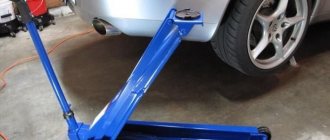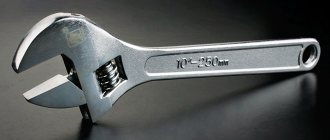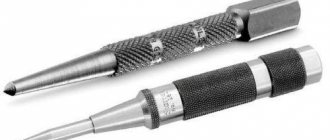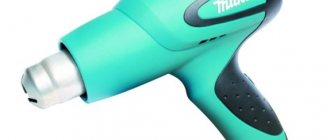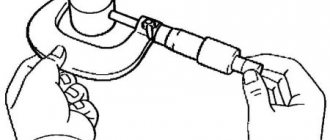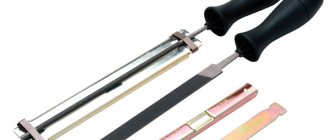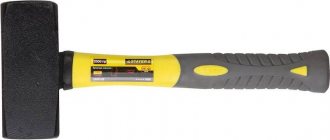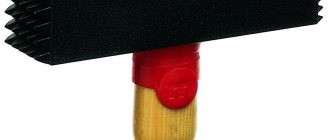The evolution of tools has led to the fact that hand-held instruments have been replaced by electric ones. Some assistants have not changed their appearance over many years of use; such a tool can be considered a file, with which you can perform various operations.
What is a file?
There are many types of files. This easy-to-use multi-blade tool is known to every craftsman; it can be used to quickly and easily remove the top coating from a workpiece. A variety of materials can be processed with a file; it can easily handle metal, plastic, wood, textolite and others. Using a file, you can gradually and carefully cut off the layers layer by layer, giving the product the required shape, size, or making the surface rough if necessary.
What does a file look like?
A good craftsman should have several files in his arsenal. This tool looks like a metal rod that is attached to a handle. Ease of use and safety in operation depend on it; this is an important element of the file. The handle can be made of wood; a ring is attached to such models to protect the tool from splitting, and it is coated with varnish or paint to prevent the material from rotting. Files with plastic handles are complemented by rubberized inserts for ease of use. The main parts of the file also include:
- shank;
- heel;
- a working part having a face, a toe and an edge.
How does a file work?
You can expand the diameter of the workpiece or shorten any part using a high-quality file. Teeth applied to a metal rod remove parts of the material being processed. A large wood file immediately removes a thick layer of the product; experts advise starting work with a tool with medium teeth, gradually changing files. It is necessary to complete the surface treatment with a product with the smallest notch. With this method of working, the surface will remain smooth and there will be no pronounced grooves on it.
Subtleties of work
Finding out what a rasp is used for and learning how to work with it, you should gradually learn specialized subtleties that allow you to achieve much better results.
- Having already completed work on the part, it is necessary to ease the pressure on the rasp so that the work turns out softer and more delicate. The fact is that the pressure force affects the depth of the recesses left by the tool on the surface.
- When working with wood, wood dust always remains on the tool. It needs to be brushed off. It is also recommended to fan the surface being treated as often as possible. This way it will be much clearer how the work is going, what needs to be faked or corrected, where you can use the rasp one more time.
- If you have to work on a thin or too small area, it is better to take not an ordinary rasp, which is useless here, but a miniature corrugated one. With its help you can easily reach the most difficult places.
What is a file for?
Different types of files perform many functions. For metalworking work, tools with double teeth are suitable, the length of which can be different. Special files are a special type of device that is widely used on an industrial scale; they eliminate major imperfections and adjust large parts with differences in the size of the grooves or differences in the curvature of the surface of the product. To process small parts or work in hard-to-reach places, small files are used - needle files.
Form
The standard tool is a flat rasp.
It is used when it is necessary to trim workpieces, remove burrs from the surface of metal or wooden products. Rasps of the presented shape are made from the strongest tool steel. What is a round rasp? Devices with a rounded working surface open up the possibility of processing all kinds of holes, uneven surfaces of non-solid materials. Often, such tools are used when performing plumbing work.
As for semicircular rasps, the latter can be used when processing not only concave, but also flat workpieces. They are used when cleaning the surfaces of large diameter holes.
What is the difference between a rasp and a file?
Rough processing of parts can be entrusted to a rasp. This type of file is used for rough work; it has the largest notches, which is what makes it stand out. To achieve the best effect in your work, experts advise using a rasp in turn, and then a diamond file. A set of rasps is a good buy; several tools will make the work of a home craftsman much easier. The minimum number of products for working with wood, soft metal, plastic and leather consists of the following types of rasps:
- flat;
- round;
- semicircular.
Types of files
Manual processing of metal blanks is carried out using a variety of files. It is necessary for a home craftsman to understand their types, understand how they differ, what they are and what they are intended for.
- A rough file
is a tool with a large notch; it is used for final, finishing grinding of the surface. - The personal file
has a medium cut size and is used as an intermediate option when processing surfaces. - A velvet file
with the smallest notch is necessary for finishing parts and sanding them.
Marking of files
It is difficult to entrust fine processing of workpieces to machines, but with a set of files, you can cope with this task. The marking of the tool must comply with GOST; it must reflect the main characteristics of the tool:
- Class
– from 1 to 6. - Length
– looks like the number after the Latin letter L. - Type of notch
– from 0 to 5. - Tooth hardness
is double digit after abbreviation HRC. - Type of steel
– U, if the tool is made of carbon alloys, ШХ, if the file is made of alloy steel.
How to choose a file?
Choosing a tool such as a file is not an easy task. Many factors should be taken into account when purchasing this simple tool; experienced specialists advise the master to pay attention to the following factors:
- The shape of the working surface
is selected depending on the type of workpieces that you plan to work with. - The hardness of the file
is selected depending on the type of material that will have to be worked with. - The size of the notches
is an important parameter that should not be neglected; it would be ideal to have tools with several types of notches for rough and finishing processing. - The length of
the file blade is selected depending on the size of the workpiece. A small tool works well on small surfaces and holes, but large files require large files. - The type of tool
- a hand or band file - is necessary on the farm, depending on the preferences of the master. Modern automatic devices are suitable for processing complex curved workpieces, while for simple parts, manual tools that are familiar to many are more acceptable.
File shapes
It is difficult to process any surface with a standard file; a specialist working with metal and other materials should have tools for all occasions in his arsenal. Craftsmen have come up with various shapes of files that help achieve amazing results when working with specific shapes of workpieces.
- round is suitable for grinding oval or round holes;
- square is designed to work with rectangular holes;
- rhombic is suitable for processing corners and inclined surfaces;
- flat copes well with uneven parts;
- triangular is suitable for processing internal corners of various shapes;
Types of file cuts
Depending on the length and size of the section, each file must have a corresponding notch number, from 0 to 5.
- 0 and 1
– the largest bastard files, capable of removing from 0.05 to 0.1 mm of a metal surface; - 2 and 3
– personal files, process the product to 0.02-0.06 mm; - 4 and 5
– velvet files, capable of removing a layer of 0.01-0.03 mm.
File handle
A handle is installed on the file shank to make the tool convenient to use. Its surface must be inspected before purchasing, and preference should be given to even and smooth options without burrs or chips. Some sets of metal files are equipped with a universal interchangeable handle, which is quickly and easily installed on any tool and significantly saves space in the garage. To secure such a handle to the rod, you need to put it on the shank and gently tap its base with a hammer.
Proper use of the rasp
Proper use of a rasp file eliminates the occurrence of defects on the surface of the wood being processed, and also protects the carpenter from injury and damage to the tool. Technological features of the design of the working part of the tool require compliance with certain rules when working with it:
- Products must first be thoroughly cleaned of wood sanding dust and shavings. This can be done using brushes with different bristles softness. This is important for the carpenter to correctly visually assess the degree of required polishing of the product.
- For convenience, a wooden workpiece is often clamped in a vice. This ensures the correct angle of the fixture. For quality work, it is important to maintain a 90° angle between the tool and the arm bent at the elbow.
- During the filing process, a balance of forces applied when pressing with the right and left hands during the working stroke must be maintained. Thus, during the grinding process, the wood will not receive new defects: chips, cuts and burrs.
- Surface treatment is carried out diagonally to the wood fibers. This is due to the peculiarities of the macroscopic structure of wood.
How to use a file?
Working with any tool requires skills and abilities from the master, the most important thing is compliance with safety precautions. Before work, you should decide what shape of tool you need to take to process a specific surface: a flat, round or diamond file. It is most convenient to clamp the workpiece in a vice so that it does not move, apply markings and then begin grinding. To process large surfaces, movements with a file should be alternated, moving it back and forth, left and right, and diagonally.
How to use a rasp correctly?
So we found out what a rasp is and what types of devices are available to craftsmen.
Now let's look at the features of proper operation of the tool. When starting work, it is recommended to hold the rasp firmly by the handle. With the other hand you need to press its end to the surface of the material being processed. It is with this positioning of the hands that reliable control over the instrument will be exercised.
When preparing to work with a rasp, the workpiece must be firmly secured in a clamp. Holding the tool with both hands, it is necessary to move its textured part along the workpiece. The rasp must be moved diagonally in relation to the wood fibers. This will make the surface being treated as smooth as possible.
How to restore a file at home?
Many novice craftsmen believe that a tool with traces of paint or covered with rust cannot be restored, and they throw it away. Any metal files can be cleaned, sharpened and used for a long time. After work on restoring the metal rod, you can also update the handle; it is recommended to carefully remove the old one if it is cracked and has defects. A new one will last a long time if it is treated with special wood products, varnished or painted.
How to clean a file?
Many craftsmen have encountered a problem when files become covered with rust and cannot be used. You can clean both straight and triangular files, as well as other options, using improvised materials at home.
- Pour hot water into the container where the entire file is placed and clean the surface of the tool with an old toothbrush and dishwashing detergent.
- Drain the soap solution, dry the file, prepare a liquid for cleaning the surface of the tool, consisting of 1 tbsp. hot water and 2 heaped teaspoons of citric acid. Pour the prepared solution into the file and leave it in it for 12 hours.
How to sharpen a file?
Frequent use of a file can cause the tool to become dull. Working with copper, aluminum and stainless steel often causes small metal particles to get stuck between the teeth. A rough file becomes clogged, its surface loses its functions, and its cutting part needs to be sharpened. There are several options that can return the file to its original appearance.
- The chemical method
is fast and effective. Before sharpening, the tool must be cleaned, degreased and dried. The solution into which the file is then placed consists of water (86%), nitric acid (8%) and sulfuric acid (6%). In 10 minutes. After immersion, the instrument must be removed and washed thoroughly. - The electrochemical method
is similar to the previous one. The proportions of the solution in it are slightly different; water (80%), nitric acid (9%) and sulfuric acid (11%) are taken. The file must be dipped into the prepared mixture and a low frequency current must be passed through using aluminum plates. - The mechanical method
of sharpening tools requires a special device - a milling machine. First, the file is fired in a special furnace at a temperature of about 800°C, after which its surface is ground on a machine. Using a chisel, notches are formed on a smooth file. To harden the tool, place it in a solution consisting of water (50 l), salt (2 kg) and hydrochloric acid (1 l). For hardening small instruments, the proportions are reduced. - The sandblasting method
of sharpening files requires the ability to work with special tools. The cutting surface is restored using fine sand, which is passed through a nozzle under pressure. - Folk methods of sharpening
tools are widely used by home craftsmen. Experts recommend using different compounds to restore the working surface of files: citric acid, ferric chloride, vinegar.
